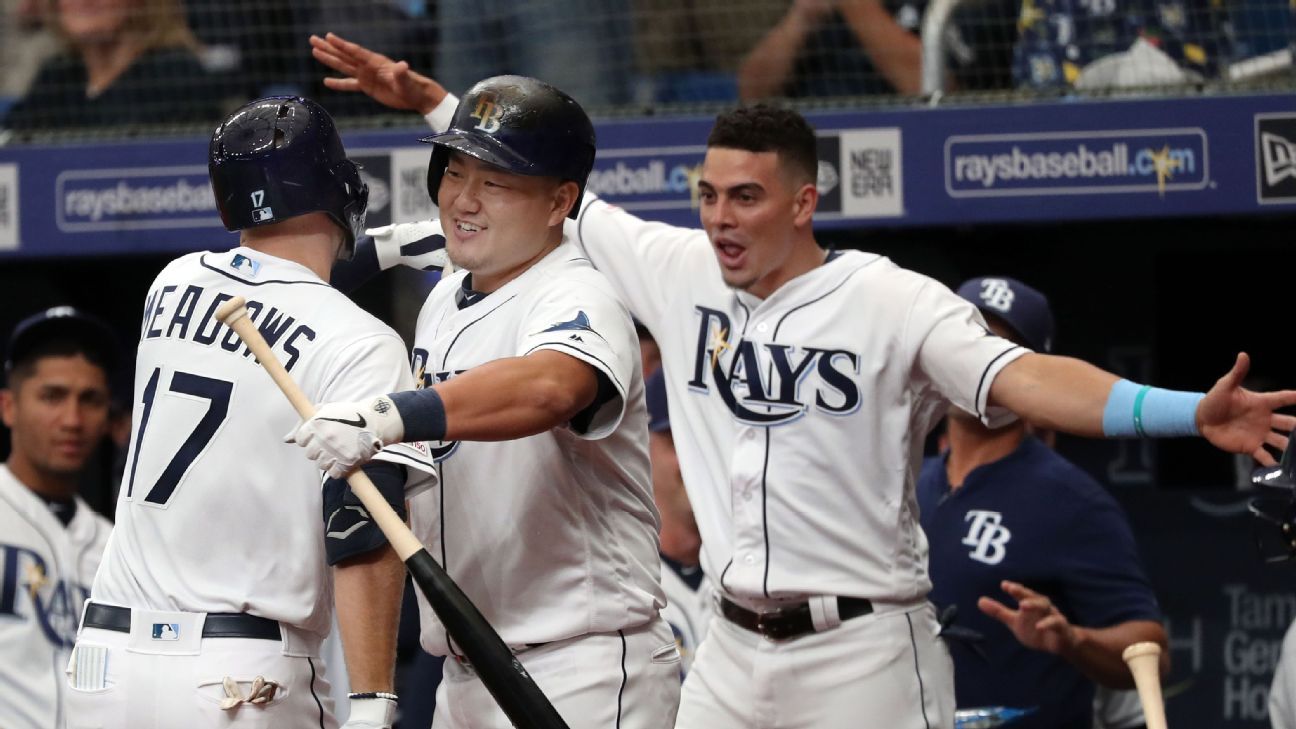On the surface, Major League Baseball’s official Opening Day payroll numbers do not offer any surprises. The Boston Red Sox are paying the most in actual salaries as well as the number used in luxury-tax calculations. The Chicago Cubs and New York Yankees also have payrolls in excess of $200 million. The average salary is almost exactly flat year-over-year despite industry revenue gains.
A deeper dive into the numbers offers a few important lessons as MLB and the MLB Players Association prepare to discuss the game’s economics in early bargaining sessions expected to start soon. Here are five takeaways.
1) The best team in baseball has the lowest payroll
And it’s not really close. The Tampa Bay Rays have MLB’s best winning percentage with a 16-8 record. Their plus-48 run differential is tops in the big leagues, too. And they’re doing it with a 40-man roster making slightly more than $50 million this season.
The Rays’ actual payroll number, as calculated by the league, is $62,143,354. The base salaries of their entire 40-man roster are $53,647,378 — or $1.35 million less than the base salaries Detroit is paying Miguel Cabrera and Jordan Zimmermann this year. The chasm between the $53.6 million and $62.1 million comes from signing-bonus dollars — including long-ago-paid bonuses for the since-traded Chris Archer and Evan Longoria — and money kicked in to cover Edwin Encarnacion‘s salary. (More on that later.)
MLB’s calculation factors in only a prorated portion of Blake Snell’s $3 million signing bonus on his new long-term deal, so the $53.6 million number isn’t spot on in terms of actual cash outlay. But it’s close enough. It’s nearly $19 million less than the next-lowest team, Miami, and not even a quarter of Boston’s $220.6 million in base wages.
One one hand, it’s a testament to the Rays’ ability to build an exceedingly cost-effective core through the draft, international free agency, trades and signings. It’s also a reminder that however dreadful their stadium, however miserable their TV deal, however rough their economic reality, the Rays are spending far less than their competitors.
2) The teams that spend the highest proportion of their revenues will surprise you
Excuse the mixing of numbers here, but since MLB keeps individual teams’ revenue numbers a tightly held secret. The closest facsimile that exists is Forbes’ annual valuations. While the league says the numbers are not accurate, the estimated revenues are calculated using a consistent formula and thus provide a reasonable constant against which we can measure the percentage of money spent.
The clear champion in terms of pouring money back into the major league team is the Washington Nationals. MLB calculates their payroll at $191.6 million, fifth behind the three $200 million-plus payroll behemoths and the Los Angeles Dodgers, at $195.4 million. Forbes estimates the Nationals’ revenue last year, meanwhile, at $336 million, which is 12th among major league teams. Adding to the nearly $192 million payroll another $14,509,516 every team pays in benefits, the Nationals would be spending more than 60 percent of revenue on their 40-man roster.
Using that payroll-plus-benefits-divided-by-revenue formula, other big spenders include Cincinnati (56 percent), Colorado (55.7 percent), Seattle (52.6 percent) and Toronto (51.4 percent).
The lowest? The Yankees, whose $668 million in revenue dwarfs even a $200 million-plus payroll. Just ahead of them are Tampa Bay (33.6 percent), Pittsburgh (36.3 percent), Baltimore (37.8 percent) and Atlanta (38.2 percent).
3) Next to no money is spent going over the luxury tax
And when we say next to no money, we mean next to no money. Three teams are currently over the $206 million threshold: the Red Sox, Cubs and Yankees. Combined, they would pay $21,005,073 in penalties. That is 0.05 percent of the $4.55 billion total for all 30 teams’ luxury-tax calculations. As in, 1/2,000th.
It was even lower last year, when the Yankees and Dodgers were among the teams resetting their luxury-tax base rate, which increases for multiple-time offenders. That came off back-to-back years in which the tax penalties were at least marginally higher: five teams totaling $61.2 million in 2017, six teams combining for $74.1 million in 2016.
That’s still fractional. Minuscule. Nothing. It’s still a sign that if the luxury-tax threshold doesn’t serve as a stop sign on team spending, it is at very least a flashing red. Proceed with caution, it says, and teams do.
It’s reasonable to ask whether teams would spend any more if the luxury tax did not exist. When commissioner Rob Manfred during spring training said “I reject the notion that payroll is a good measure for how much a team is trying or how successful that team is going to be,” the natural response was: Well, if that’s true, then why does the luxury tax even exist? It’s a question that the union is certain to ask during the upcoming negotiations.
4) As the sky was falling this winter, more than $4 billion was guaranteed to players
Now, it’s important to understand more than half of that nearly $4.2 billion came via contract extensions, and that those extensions were, in some cases, a function of players being so mortified by the shifting free agent market that they were happy to grab onto whatever life raft of money teams offered.
It’s important to understand, too, that every little advantage MLB gained over the last quarter-century of labor peace led to this point, where players recognize the power imbalance that seeds such decisions.
That said, both MLB and union officials agree that if an environment exists in which more than $4 billion in deals can be agreed upon, the system cannot be irretrievably broken. It is problematic. It has, mostly for players, trended in the wrong direction. It includes ridiculous incentives for teams to bury talent — see Vladimir Guerrero Jr., still a minor leaguer — and, at times, use that as a cudgel to incentivize players to sign under-market contracts. There are issues, major issues, deep-seated issues that need remedying so the sides can focus together on the sport’s future. And the money spent this winter offers hope all the whispers of a work stoppage don’t come to fruition.
5) There are more have-nots than haves
If the average total 40-man payroll this season is $135,724,912, there are 13 teams currently spending more and 17 under that mark. While this does not mean the big payroll-small payroll disparity has widened any — the standard deviation among payrolls this season is consistent with the last half-decade — it does show a concentrated money advantage among the larger-market clubs that pay revenue sharing. The split is not accidental. Almost every team above the mean pays revenue sharing. Almost every team below the mean receives it.
Whether the chasm widens going forward is worth watching. Competitive balance is important to the league and union. A game clearly by and for the rich is a game bound to fail — thus, Manfred’s likely rejoinder on the luxury-tax question. At the same time, it’s clearer than ever that a large payroll offers teams not just the capacity to spend but to fail. Big contract misses aren’t anchors. Even better, others’ big contract misses can turn into dead-money coups. (There is $54,403,334 in cash exchanged on rosters today, and high-revenue teams are almost always the ones willing to eat money.)
When the players’ association says the average salary in 2019 is $4,512,357, clearly baseball is a sport made of haves and more haves. But the game’s equilibrium, both competitively and economically, is tenuous and needs the right kinds of stewards to ensure it never falls too far out of whack.

